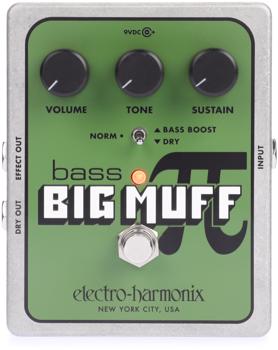Wow. My first fuzz pedal (my first pedal ever, actually, if truth be told). I figured when I was deciding (and boy did I contemplate this for a while, as I always do) on my first fuzz pedal that I should start with the “standard” and really get to familiarize my self with what the original muff sound was all about before I could really appreciate more extravagant fuzz pedals. Whether or not that worked is subject for some debate, but at least I had good intentions, right?
Electro-Harmonix pedals are something of a standard in the effects world (just like BOSS/Roland or any of the other “biggies”). Although some of their effects releases of the past, namely during the nineties were not the greatest (what was with those cheap aluminum enclosures, I ask you?!), they always sounded killer and were known for their innovative approach. I think that their muff circuit (aptly named the Big Muff) was the first fuzz pedal that was produced and a later version, the Russian Green Muff (also known as the Sovtek Green Muff, or the “Civil War” Muff) is what this current production model is based on.
CONSTRUCTION:
Thank (or insert your favorite deity here) that EHX decided to revamp their product line with the new XO series pedals. The build quality and the quality of the enclosures are NIGHT AND DAY better / sturdier than the big, bulky aluminum enclosures of their early pedals. The circuit boards are properly mounted and the construction quality is much higher overall.
FEATURES / TONE:
The proprietary Muff controls of Volume, Tone and Sustain are here in full force with the addition of a three position mini switch with Dry, Normal and Bass Boost modes (more on that later). This circuit also features not only an effected “wet” output but also a “dry” output for blending your clean and effected signals at a later point in the signal chain, or running into two separate amps, one effected and one dry.
The big three controls on this pedal are standard for pretty much all muffs and their various clones with the Tone knob controlling a sweep in the mids going from muffled to bright (for a muff). The Bass Big Muff Pi is definitely not the most versatile pedal ever made. It designed to be a wham-bam-thank-you-m’am type of pedal. The three position helps expand the versatility of this pedal somewhat, but it is still a simple pedal at the end of the day.
The three position switch with Dry, Normal, and Bass Boost modes don’t offer the most variety ever, but they are effective at what they do. The Bass Boost mode is really useful for bringing the hammer down on the mix and filling the low end out to make up for the “where’d my bass go?” syndrome that seems to plague most muff circuits (do to the sweep/scooping of the mids). I liked leaving the pedal in the boost mode the best because I had it set for DOOM and it really felt like another cabinet was added to the mix when this pedal was on. Honestly, there have only been a few pedals that really kicked me in the chest like the bass boost mode did on this pedal, however the scooped mids inherent to the muff’s design still cause some of the “disappearance effect,” but that is something you always run into with standard muff circuits.
The “dry” mode is improperly labeled in my opinion because the dry output on the pedal is also labeled as such and that can be quite confusing before you get your mind wrapped around this pedal. The three position switch has zero effect on the dry output of the pedal, which is always present if the dry output is being used. The “dry” position on the three position switch is EHX’s version of a built in blend, mixing the fuzzy tone with your clean signal.
The shortcoming of this setting is that you have no control over the ratio of wet to dry ratio like you do on other pedals. Even though the volume knob is supposed to affect the way the wet and dry signals intermingle.....it isn’t that apparent...or useful.
Overall this pedal is a great introduction to muff-type pedals, and fuzz pedals in general for that matter and I am glad that it was my first pedal. It was very helpful as a starting point into the wide world of fuzz pedals and muff clones and I recommend if not for that purpose alone.
Great for the price point, and you can pick them up on the used marked for dirt cheap if you look around ($45-65).
www.ehx.com
www.ehx.com

No comments:
Post a Comment